2001 NISSAN X-TRAIL App sensor
[x] Cancel search: App sensorPage 2609 of 3833
![NISSAN X-TRAIL 2001 Service Repair Manual SERVICE DATA AND SPECIFICATIONS (SDS)
AT-531
[ALL]
D
E
F
G
H
I
J
K
L
MA
B
AT
A/T Fluid Temperature SensorECS004N1
Remarks: Specification data are reference values.
Revolution SensorECS004N2
Dropping R NISSAN X-TRAIL 2001 Service Repair Manual SERVICE DATA AND SPECIFICATIONS (SDS)
AT-531
[ALL]
D
E
F
G
H
I
J
K
L
MA
B
AT
A/T Fluid Temperature SensorECS004N1
Remarks: Specification data are reference values.
Revolution SensorECS004N2
Dropping R](/manual-img/5/57405/w960_57405-2608.png)
SERVICE DATA AND SPECIFICATIONS (SDS)
AT-531
[ALL]
D
E
F
G
H
I
J
K
L
MA
B
AT
A/T Fluid Temperature SensorECS004N1
Remarks: Specification data are reference values.
Revolution SensorECS004N2
Dropping ResistorECS004N3
Monitor item Condition Specification (Approximately)
A/T fluid temperature sensorCold [20°C (68°F)]
↓
Hot [80°C (176°F)]1.5V
↓
0.5V2.5 kΩ
↓
0.3 kΩ
Condition Judgement standard
When moving at 20 km/h (12 MPH), use the CONSULT-II pulse frequency measuring func-
tion.*1
CAUTION:
Connect the diagnosis data link cable to the vehicle diagnosis connector.
*1: A circuit tester cannot be used to test this item.450 Hz (Approx.)
When vehicle parks.Under 1.3V or over 4.5V
Resistance12Ω
Page 2611 of 3833
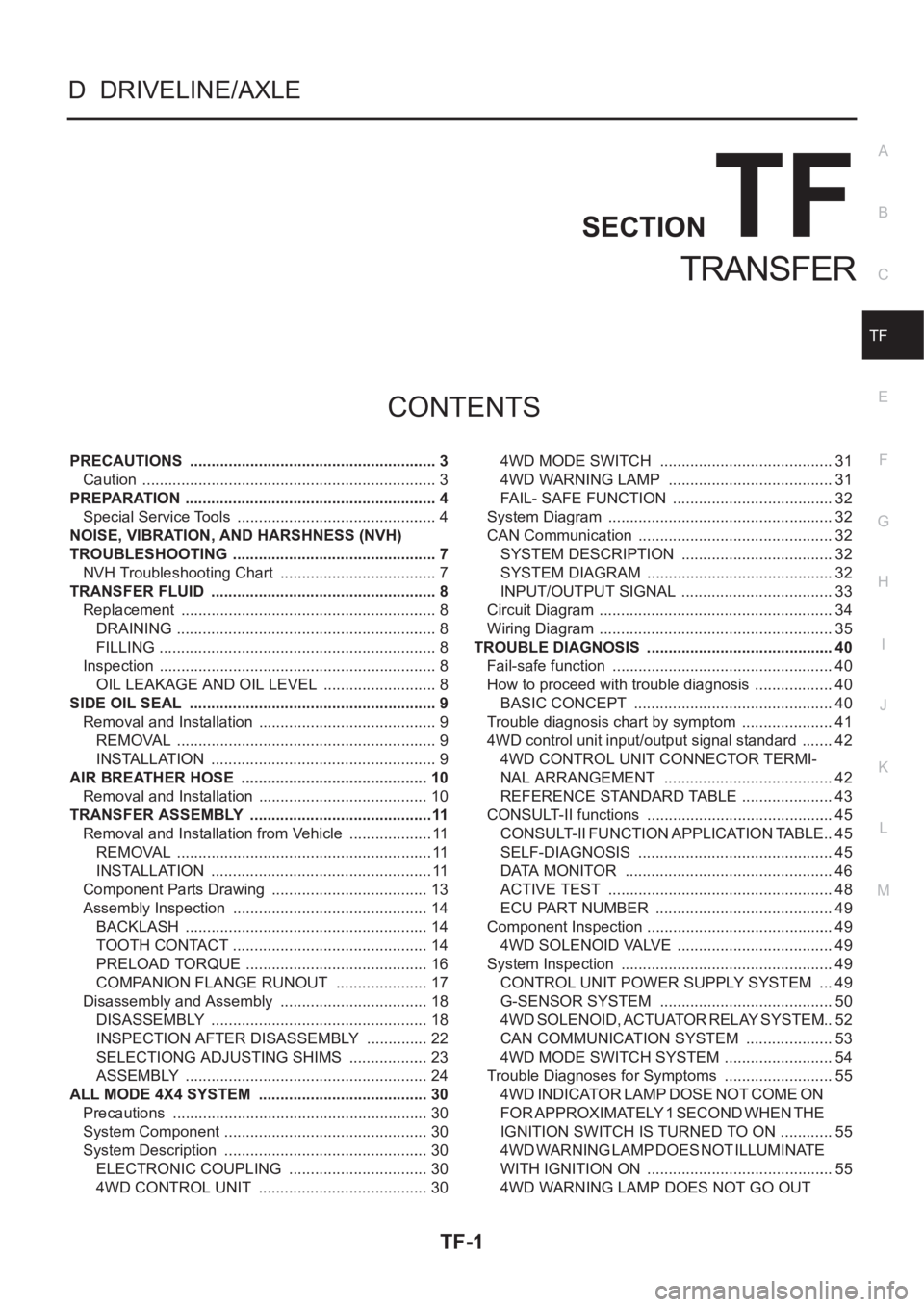
TF-1
TRANSFER
D DRIVELINE/AXLE
CONTENTS
C
E
F
G
H
I
J
K
L
M
SECTION
A
B
TF
TRANSFER
PRECAUTIONS .......................................................... 3
Caution ..................................................................... 3
PREPARATION ........................................................... 4
Special Service Tools ............................................... 4
NOISE, VIBRATION, AND HARSHNESS (NVH)
TROUBLESHOOTING ................................................ 7
NVH Troubleshooting Chart ..................................... 7
TRANSFER FLUID ..................................................... 8
Replacement ............................................................ 8
DRAINING ............................................................. 8
FILLING ................................................................. 8
Inspection ................................................................. 8
OIL LEAKAGE AND OIL LEVEL ........................... 8
SIDE OIL SEAL .......................................................... 9
Removal and Installation .......................................... 9
REMOVAL ............................................................. 9
INSTALLATION ..................................................... 9
AIR BREATHER HOSE ............................................ 10
Removal and Installation ........................................ 10
TRANSFER ASSEMBLY ...........................................11
Removal and Installation from Vehicle .................... 11
REMOVAL ............................................................ 11
INSTALLATION .................................................... 11
Component Parts Drawing ..................................... 13
Assembly Inspection .............................................. 14
BACKLASH ......................................................... 14
TOOTH CONTACT .............................................. 14
PRELOAD TORQUE ........................................... 16
COMPANION FLANGE RUNOUT ...................... 17
Disassembly and Assembly ................................... 18
DISASSEMBLY ................................................... 18
INSPECTION AFTER DISASSEMBLY ............... 22
SELECTIONG ADJUSTING SHIMS ................... 23
ASSEMBLY ......................................................... 24
ALL MODE 4X4 SYSTEM ........................................ 30
Precautions ............................................................ 30
System Component ................................................ 30
System Description ................................................ 30
ELECTRONIC COUPLING ................................. 30
4WD CONTROL UNIT ........................................ 304WD MODE SWITCH ......................................... 31
4WD WARNING LAMP ....................................... 31
FAIL- SAFE FUNCTION ...................................... 32
System Diagram ..................................................... 32
CAN Communication ...........................................
... 32
SYSTEM DESCRIPTION .................................... 32
SYSTEM DIAGRAM ............................................ 32
INPUT/OUTPUT SIGNAL .................................... 33
Circuit Diagram ....................................................... 34
Wiring Diagram ....................................................... 35
TROUBLE DIAGNOSIS ............................................ 40
Fail-safe function .................................................... 40
How to proceed with trouble diagnosis ................... 40
BASIC CONCEPT ............................................... 40
Trouble diagnosis chart by symptom ...................... 41
4WD control unit input/output signal standard ........ 42
4WD CONTROL UNIT CONNECTOR TERMI-
NAL ARRANGEMENT ........................................ 42
REFERENCE STANDARD TABLE ...................... 43
CONSULT-II functions ............................................ 45
CONSULT-II FUNCTION APPLICATION TABLE ... 45
SELF-DIAGNOSIS .............................................. 45
DATA MONITOR ................................................. 46
ACTIVE TEST ..................................................... 48
ECU PART NUMBER .......................................... 49
Component Inspection ............................................ 49
4WD SOLENOID VALVE ..................................... 49
System Inspection .................................................. 49
CONTROL UNIT POWER SUPPLY SYSTEM .... 49
G-SENSOR SYSTEM ......................................... 50
4WD SOLENOID, ACTUATOR RELAY SYSTEM ... 52
CAN COMMUNICATION SYSTEM ..................... 53
4WD MODE SWITCH SYSTEM .......................... 54
Trouble Diagnoses for Symptoms .......................... 55
4WD INDICATOR LAMP DOSE NOT COME ON
FOR APPROXIMATELY 1 SECOND WHEN THE
IGNITION SWITCH IS TURNED TO ON ............. 55
4WD WARNING LAMP DOES NOT ILLUMINATE
WITH IGNITION ON ............................................ 55
4WD WARNING LAMP DOES NOT GO OUT
Page 2640 of 3833
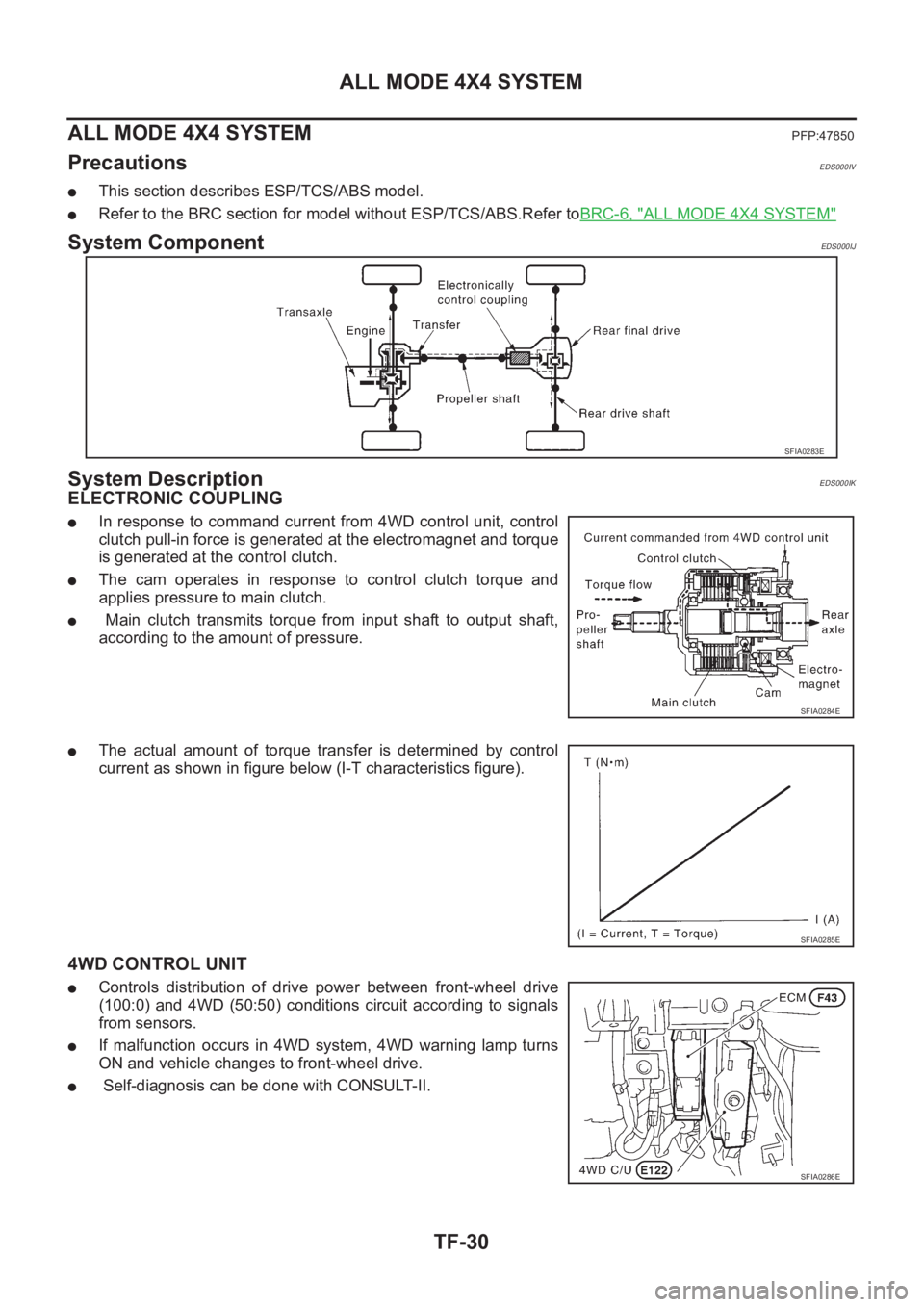
TF-30
ALL MODE 4X4 SYSTEM
ALL MODE 4X4 SYSTEM
PFP:47850
PrecautionsEDS000IV
●This section describes ESP/TCS/ABS model.
●Refer to the BRC section for model without ESP/TCS/ABS.Refer toBRC-6, "ALL MODE 4X4 SYSTEM"
System ComponentEDS000IJ
System DescriptionEDS000IK
ELECTRONIC COUPLING
●In response to command current from 4WD control unit, control
clutch pull-in force is generated at the electromagnet and torque
is generated at the control clutch.
●The cam operates in response to control clutch torque and
applies pressure to main clutch.
● Main clutch transmits torque from input shaft to output shaft,
according to the amount of pressure.
●The actual amount of torque transfer is determined by control
current as shown in figure below (I-T characteristics figure).
4WD CONTROL UNIT
●Controls distribution of drive power between front-wheel drive
(100:0) and 4WD (50:50) conditions circuit according to signals
from sensors.
●If malfunction occurs in 4WD system, 4WD warning lamp turns
ON and vehicle changes to front-wheel drive.
● Self-diagnosis can be done with CONSULT-II.
SFIA0283E
SFIA0284E
SFIA0285E
SFIA0286E
Page 2641 of 3833
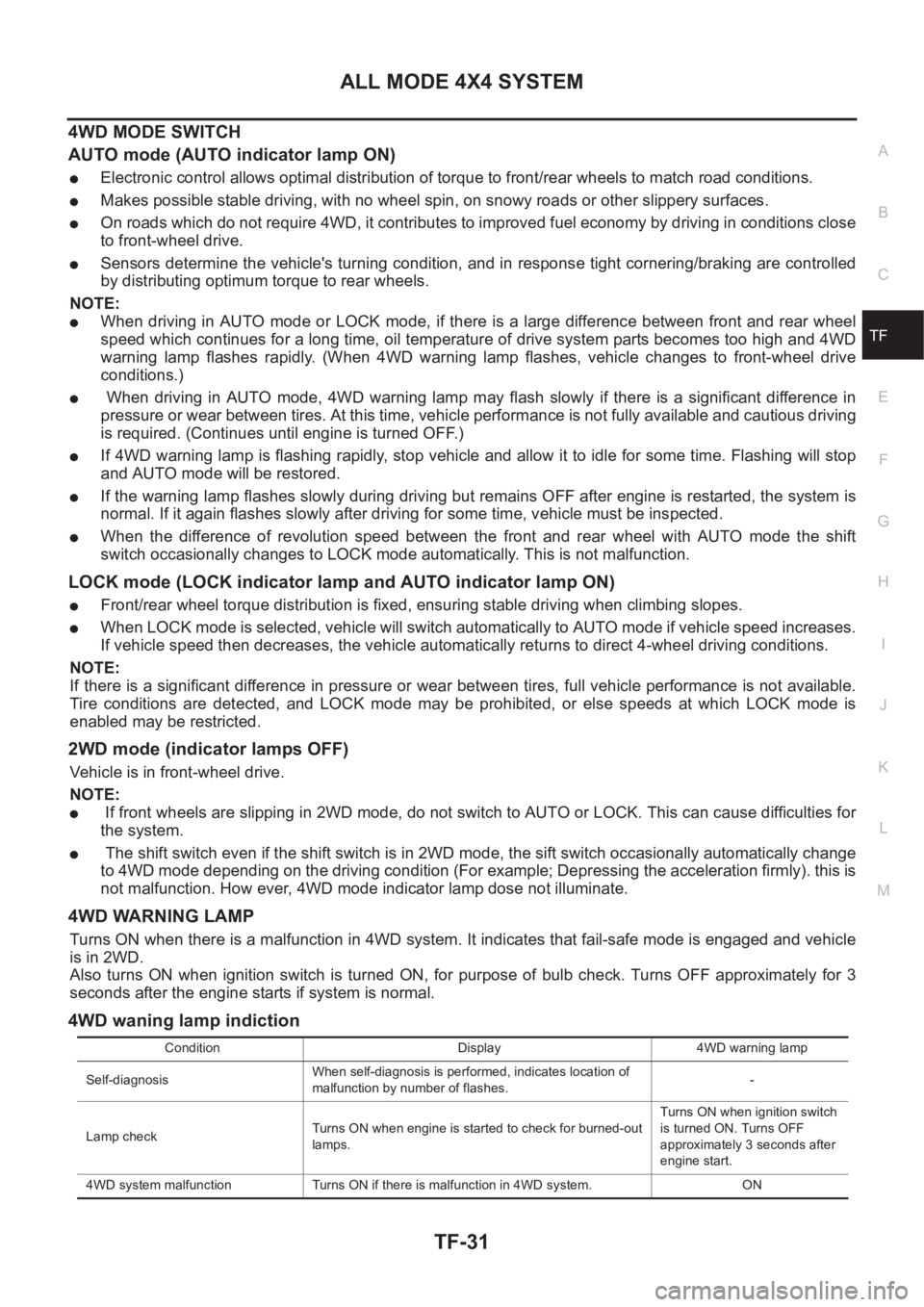
ALL MODE 4X4 SYSTEM
TF-31
C
E
F
G
H
I
J
K
L
MA
B
TF
4WD MODE SWITCH
AUTO mode (AUTO indicator lamp ON)
●Electronic control allows optimal distribution of torque to front/rear wheels to match road conditions.
●Makes possible stable driving, with no wheel spin, on snowy roads or other slippery surfaces.
●On roads which do not require 4WD, it contributes to improved fuel economy by driving in conditions close
to front-wheel drive.
●Sensors determine the vehicle's turning condition, and in response tight cornering/braking are controlled
by distributing optimum torque to rear wheels.
NOTE:
●When driving in AUTO mode or LOCK mode, if there is a large difference between front and rear wheel
speed which continues for a long time, oil temperature of drive system parts becomes too high and 4WD
warning lamp flashes rapidly. (When 4WD warning lamp flashes, vehicle changes to front-wheel drive
conditions.)
● When driving in AUTO mode, 4WD warning lamp may flash slowly if there is a significant difference in
pressure or wear between tires. At this time, vehicle performance is not fully available and cautious driving
is required. (Continues until engine is turned OFF.)
●If 4WD warning lamp is flashing rapidly, stop vehicle and allow it to idle for some time. Flashing will stop
and AUTO mode will be restored.
●If the warning lamp flashes slowly during driving but remains OFF after engine is restarted, the system is
normal. If it again flashes slowly after driving for some time, vehicle must be inspected.
●When the difference of revolution speed between the front and rear wheel with AUTO mode the shift
switch occasionally changes to LOCK mode automatically. This is not malfunction.
LOCK mode (LOCK indicator lamp and AUTO indicator lamp ON)
●Front/rear wheel torque distribution is fixed, ensuring stable driving when climbing slopes.
●When LOCK mode is selected, vehicle will switch automatically to AUTO mode if vehicle speed increases.
If vehicle speed then decreases, the vehicle automatically returns to direct 4-wheel driving conditions.
NOTE:
If there is a significant difference in pressure or wear between tires, full vehicle performance is not available.
Tire conditions are detected, and LOCK mode may be prohibited, or else speeds at which LOCK mode is
enabled may be restricted.
2WD mode (indicator lamps OFF)
Vehicle is in front-wheel drive.
NOTE:
● If front wheels are slipping in 2WD mode, do not switch to AUTO or LOCK. This can cause difficulties for
the system.
● The shift switch even if the shift switch is in 2WD mode, the sift switch occasionally automatically change
to 4WD mode depending on the driving condition (For example; Depressing the acceleration firmly). this is
not malfunction. How ever, 4WD mode indicator lamp dose not illuminate.
4WD WARNING LAMP
Turns ON when there is a malfunction in 4WD system. It indicates that fail-safe mode is engaged and vehicle
is in 2WD.
Also turns ON when ignition switch is turned ON, for purpose of bulb check. Turns OFF approximately for 3
seconds after the engine starts if system is normal.
4WD waning lamp indiction
Condition Display 4WD warning lamp
Self-diagnosisWhen self-diagnosis is performed, indicates location of
malfunction by number of flashes.-
Lamp checkTurns ON when engine is started to check for burned-out
lamps.Turns ON when ignition switch
is turned ON. Turns OFF
approximately 3 seconds after
engine start.
4WD system malfunction Turns ON if there is malfunction in 4WD system. ON
Page 2653 of 3833
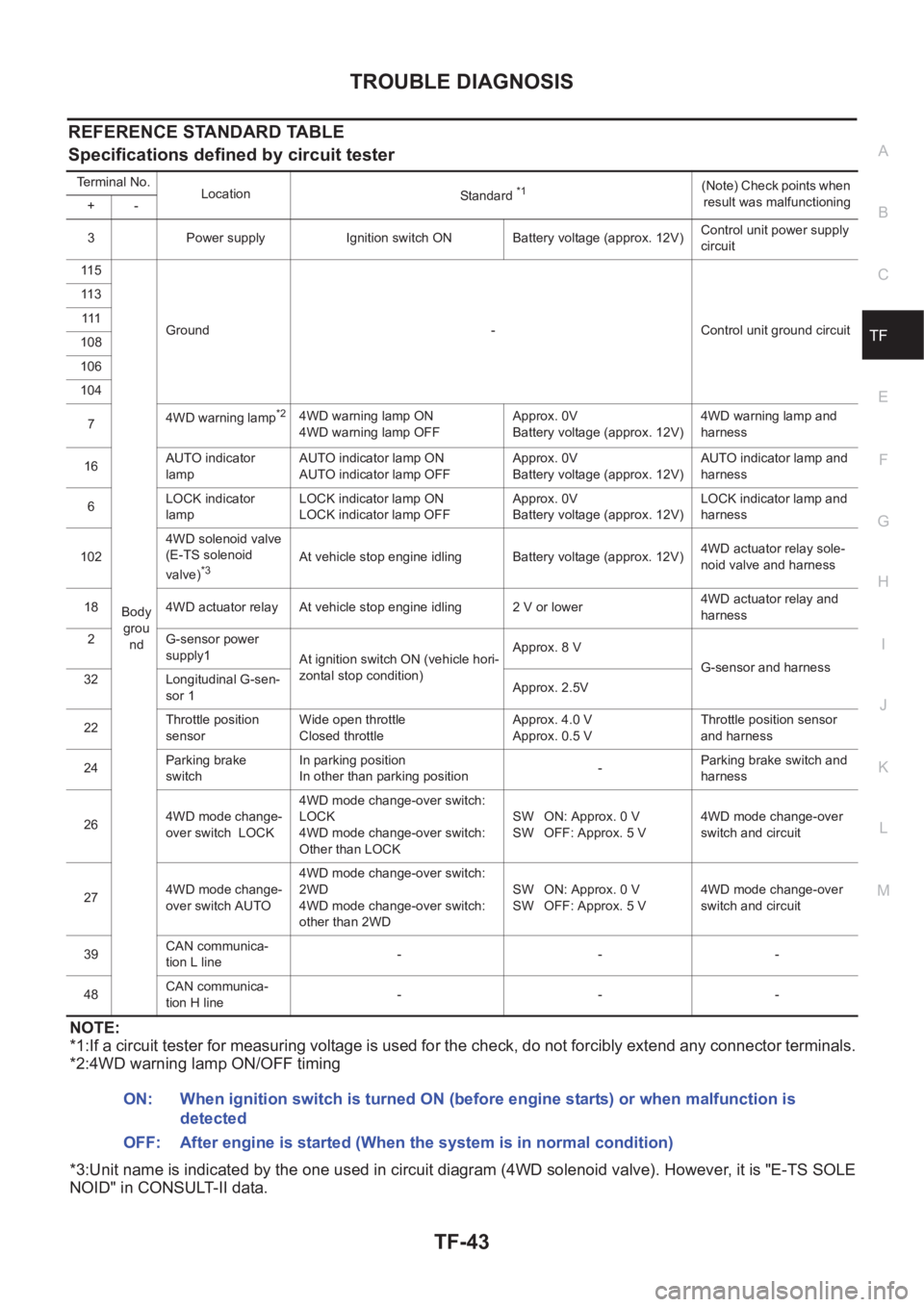
TROUBLE DIAGNOSIS
TF-43
C
E
F
G
H
I
J
K
L
MA
B
TF
REFERENCE STANDARD TABLE
Specifications defined by circuit tester
NOTE:
*1:If a circuit tester for measuring voltage is used for the check, do not forcibly extend any connector terminals.
*2:4WD warning lamp ON/OFF timing
*3:Unit name is indicated by the one used in circuit diagram (4WD solenoid valve). However, it is "E-TS SOLE
NOID" in CONSULT-II data.
Terminal No.
Location
Standard *1(Note) Check points when
result was malfunctioning
+-
3 Power supply Ignition switch ON Battery voltage (approx. 12V)Control unit power supply
circuit
11 5
Body
grou
ndGround - Control unit ground circuit 11 3
111
108
106
104
74WD warning lamp
*24WD warning lamp ON
4WD warning lamp OFFApprox. 0V
Battery voltage (approx. 12V)4WD warning lamp and
harness
16AUTO indicator
lampAUTO indicator lamp ON
AUTO indicator lamp OFFApprox. 0V
Battery voltage (approx. 12V)AUTO indicator lamp and
harness
6LOCK indicator
lampLOCK indicator lamp ON
LOCK indicator lamp OFFApprox. 0V
Battery voltage (approx. 12V)LOCK indicator lamp and
harness
1024WD solenoid valve
(E-TS solenoid
valve)
*3At vehicle stop engine idling Battery voltage (approx. 12V)4WD actuator relay sole-
noid valve and harness
18 4WD actuator relay At vehicle stop engine idling 2 V or lower4WD actuator relay and
harness
2 G-sensor power
supply1
At ignition switch ON (vehicle hori-
zontal stop condition)Approx. 8 V
G-sensor and harness
32 Longitudinal G-sen-
sor 1Approx. 2.5V
22Throttle position
sensorWide open throttle
Closed throttleApprox. 4.0 V
Approx. 0.5 VThrottle position sensor
and harness
24Parking brake
switchIn parking position
In other than parking position-Parking brake switch and
harness
264WD mode change-
over switch LOCK4WD mode change-over switch:
LOCK
4WD mode change-over switch:
Other than LOCKSW ON: Approx. 0 V
SW OFF: Approx. 5 V4WD mode change-over
switch and circuit
274WD mode change-
over switch AUTO4WD mode change-over switch:
2WD
4WD mode change-over switch:
other than 2WDSW ON: Approx. 0 V
SW OFF: Approx. 5 V4WD mode change-over
switch and circuit
39CAN communica-
tion L line---
48CAN communica-
tion H line---
ON: When ignition switch is turned ON (before engine starts) or when malfunction is
detected
OFF: After engine is started (When the system is in normal condition)
Page 2654 of 3833
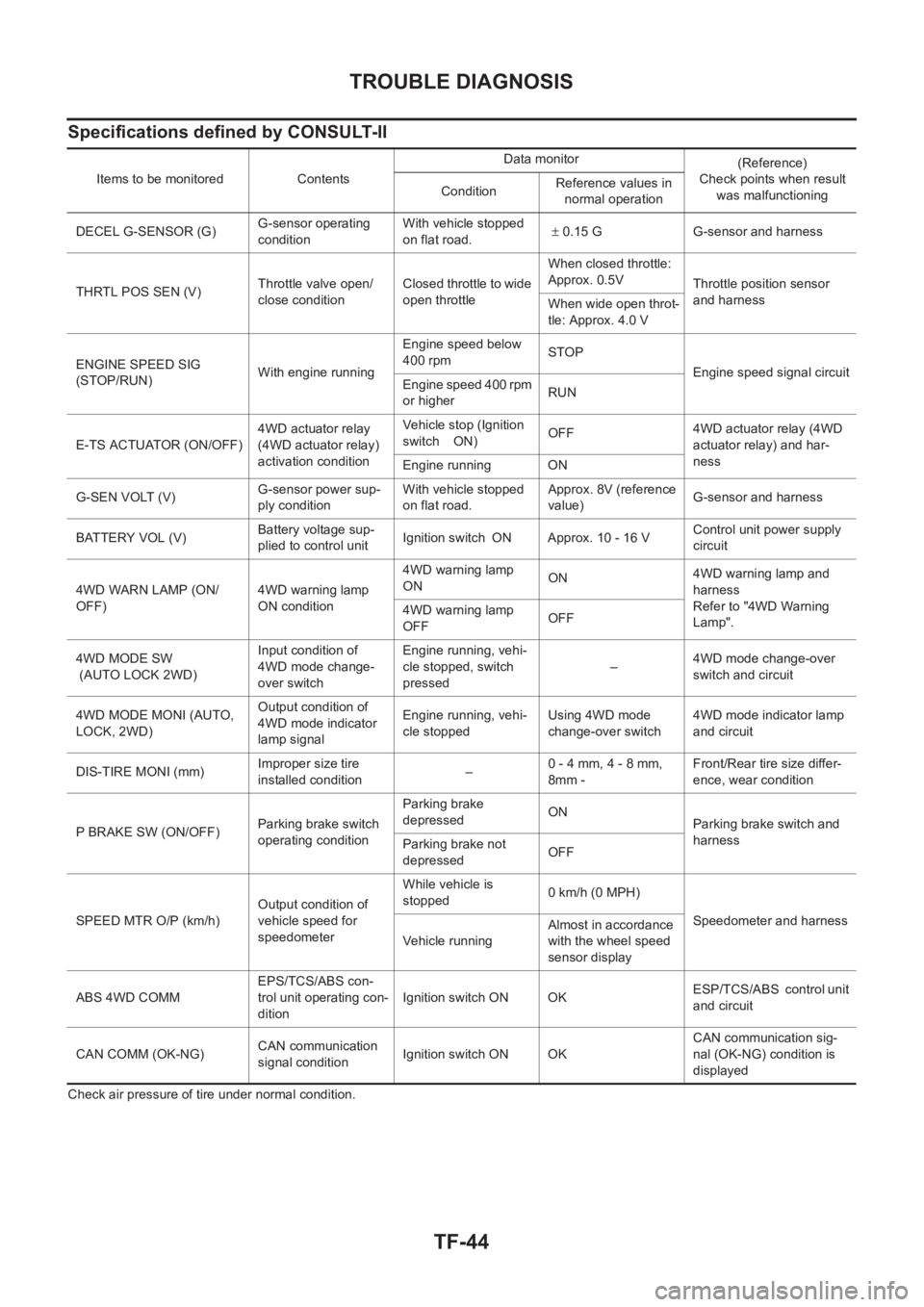
TF-44
TROUBLE DIAGNOSIS
Specifications defined by CONSULT-II
Check air pressure of tire under normal condition.Items to be monitored ContentsData monitor
(Reference)
Check points when result
was malfunctioning ConditionReference values in
normal operation
DECEL G-SENSOR (G)G-sensor operating
conditionWith vehicle stopped
on flat road.± 0.15 G G-sensor and harness
THRTL POS SEN (V)Throttle valve open/
close conditionClosed throttle to wide
open throttleWhen closed throttle:
Approx. 0.5V
Throttle position sensor
and harness
When wide open throt-
tle: Approx. 4.0 V
ENGINE SPEED SIG
(STOP/RUN)With engine runningEngine speed below
400 rpmSTOP
Engine speed signal circuit
Engine speed 400 rpm
or higherRUN
E-TS ACTUATOR (ON/OFF)4WD actuator relay
(4WD actuator relay)
activation conditionVehicle stop (Ignition
switch ON)OFF4WD actuator relay (4WD
actuator relay) and har-
ness
Engine running ON
G-SEN VOLT (V)G-sensor power sup-
ply conditionWith vehicle stopped
on flat road.Approx. 8V (reference
value)G-sensor and harness
BATTERY VOL (V)Battery voltage sup-
plied to control unitIgnition switch ON Approx. 10 - 16 VControl unit power supply
circuit
4WD WARN LAMP (ON/
OFF)4WD warning lamp
ON condition4WD warning lamp
ONON4WD warning lamp and
harness
Refer to "4WD Warning
Lamp". 4WD warning lamp
OFFOFF
4WD MODE SW
(AUTO LOCK 2WD)Input condition of
4WD mode change-
over switchEngine running, vehi-
cle stopped, switch
pressed–4WD mode change-over
switch and circuit
4WD MODE MONI (AUTO,
LOCK, 2WD)Output condition of
4WD mode indicator
lamp signalEngine running, vehi-
cle stoppedUsing 4WD mode
change-over switch4WD mode indicator lamp
and circuit
DIS-TIRE MONI (mm)Improper size tire
installed condition
–0 - 4 mm, 4 - 8 mm,
8mm -Front/Rear tire size differ-
ence, wear condition
P BRAKE SW (ON/OFF)Parking brake switch
operating conditionParking brake
depressedON
Parking brake switch and
harness
Parking brake not
depressedOFF
SPEED MTR O/P (km/h)Output condition of
vehicle speed for
speedometerWhile vehicle is
stopped 0 km/h (0 MPH)
Speedometer and harness
Ve h i c le r u n n in gAlmost in accordance
with the wheel speed
sensor display
ABS 4WD COMMEPS/TCS/ABS con-
trol unit operating con-
ditionIgnition switch ON OKESP/TCS/ABS control unit
and circuit
CAN COMM (OK-NG)CAN communication
signal conditionIgnition switch ON OKCAN communication sig-
nal (OK-NG) condition is
displayed
Page 2655 of 3833
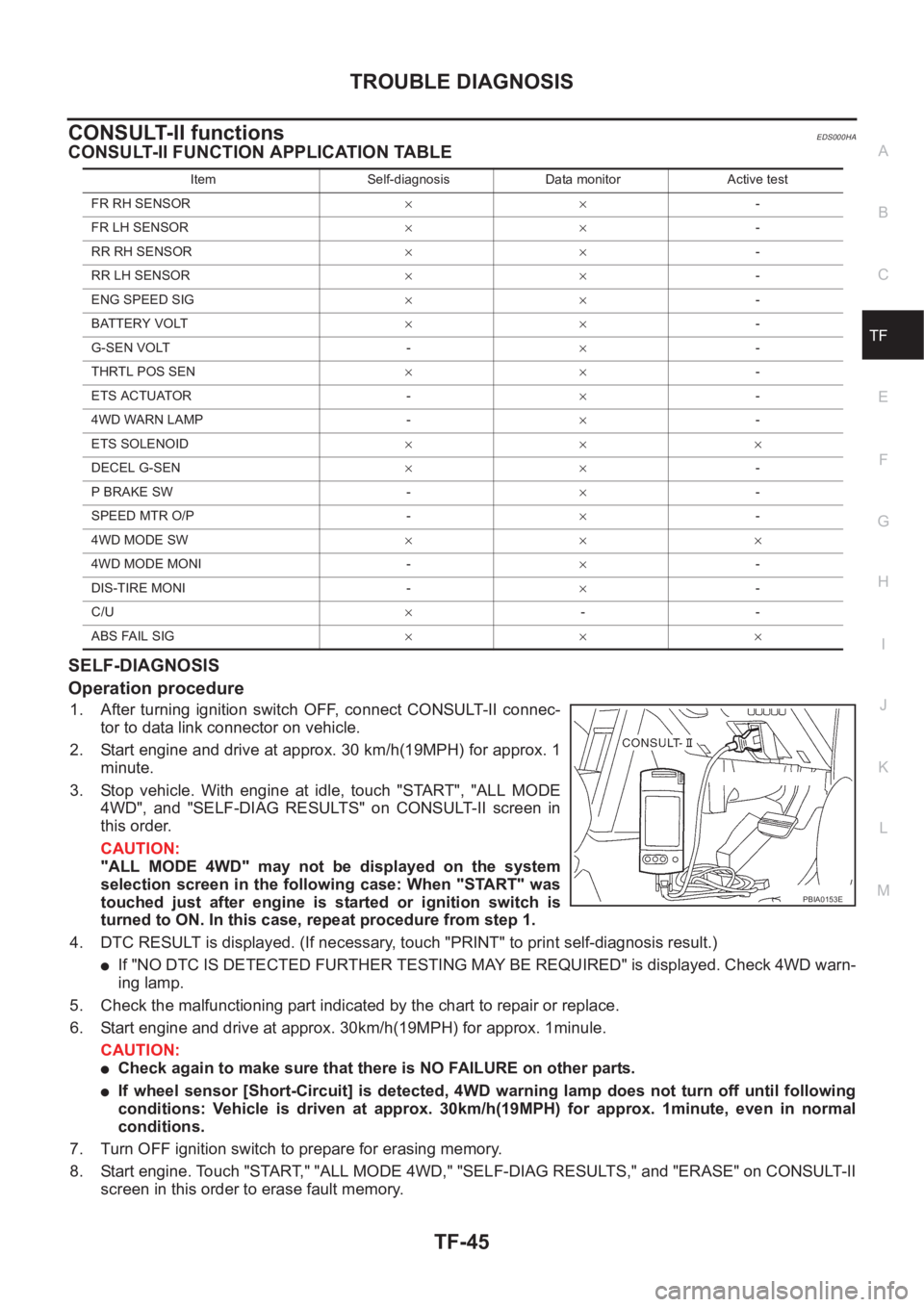
TROUBLE DIAGNOSIS
TF-45
C
E
F
G
H
I
J
K
L
MA
B
TF
CONSULT-II functionsEDS000HA
CONSULT-II FUNCTION APPLICATION TABLE
SELF-DIAGNOSIS
Operation procedure
1. After turning ignition switch OFF, connect CONSULT-II connec-
tor to data link connector on vehicle.
2. Start engine and drive at approx. 30 km/h(19MPH) for approx. 1
minute.
3. Stop vehicle. With engine at idle, touch "START", "ALL MODE
4WD", and "SELF-DIAG RESULTS" on CONSULT-II screen in
this order.
CAUTION:
"ALL MODE 4WD" may not be displayed on the system
selection screen in the following case: When "START" was
touched just after engine is started or ignition switch is
turned to ON. In this case, repeat procedure from step 1.
4. DTC RESULT is displayed. (If necessary, touch "PRINT" to print self-diagnosis result.)
●If "NO DTC IS DETECTED FURTHER TESTING MAY BE REQUIRED" is displayed. Check 4WD warn-
ing lamp.
5. Check the malfunctioning part indicated by the chart to repair or replace.
6. Start engine and drive at approx. 30km/h(19MPH) for approx. 1minule.
CAUTION:
●Check again to make sure that there is NO FAILURE on other parts.
●If wheel sensor [Short-Circuit] is detected, 4WD warning lamp does not turn off until following
conditions: Vehicle is driven at approx. 30km/h(19MPH) for approx. 1minute, even in normal
conditions.
7. Turn OFF ignition switch to prepare for erasing memory.
8. Start engine. Touch "START," "ALL MODE 4WD," "SELF-DIAG RESULTS," and "ERASE" on CONSULT-II
screen in this order to erase fault memory.
Item Self-diagnosis Data monitor Active test
FR RH SENSOR××-
FR LH SENSOR××-
RR RH SENSOR××-
RR LH SENSOR××-
ENG SPEED SIG××-
BATTERY VOLT××-
G-SEN VOLT -×-
THRTL POS SEN××-
ETS ACTUATOR -×-
4WD WARN LAMP -×-
ETS SOLENOID×××
DECEL G-SEN××-
P BRAKE SW -×-
SPEED MTR O/P -×-
4WD MODE SW×××
4WD MODE MONI -×-
DIS-TIRE MONI -×-
C/U×--
ABS FAIL SIG×××
PBIA0153E
Page 2656 of 3833
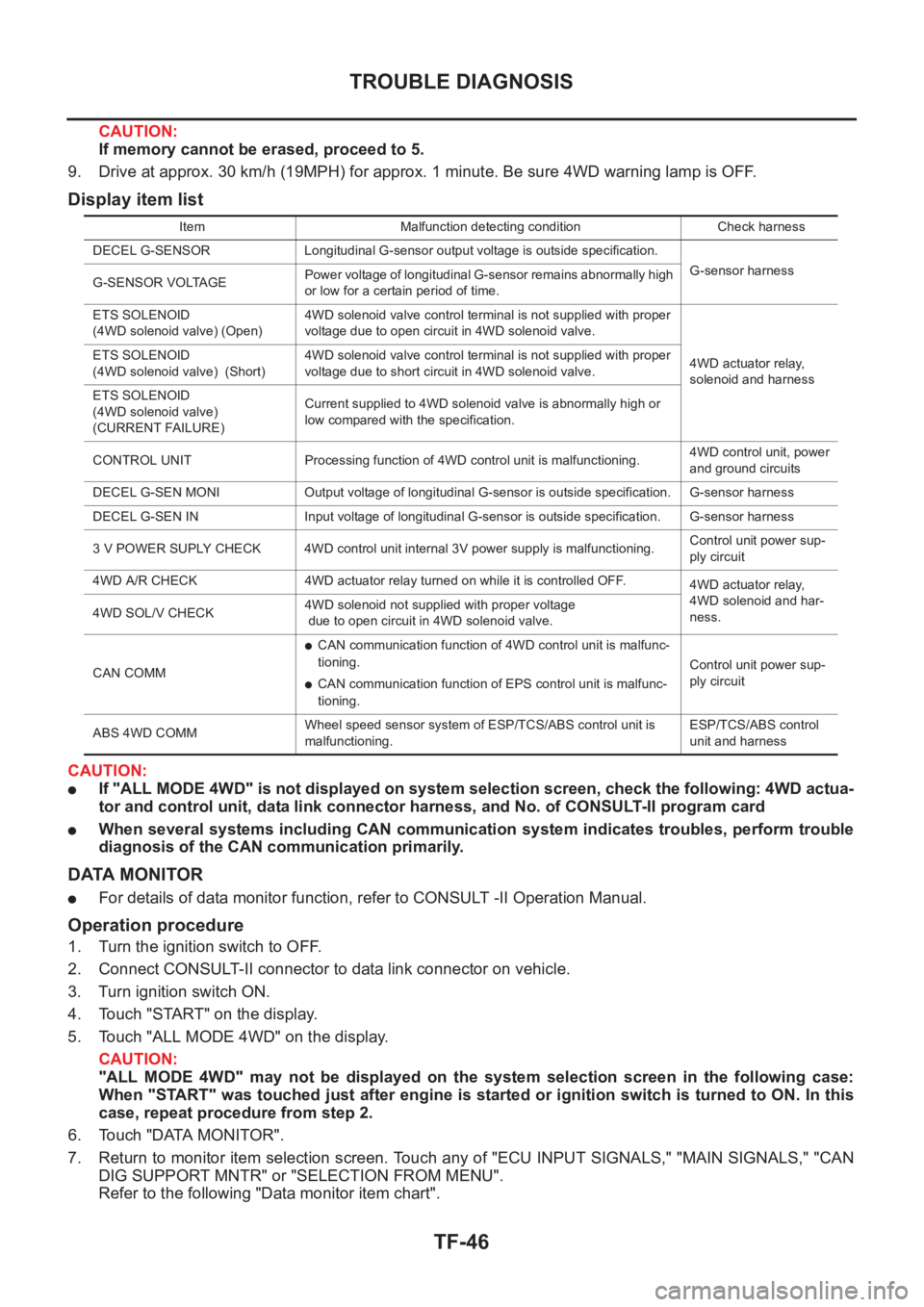
TF-46
TROUBLE DIAGNOSIS
CAUTION:
If memory cannot be erased, proceed to 5.
9. Drive at approx. 30 km/h (19MPH) for approx. 1 minute. Be sure 4WD warning lamp is OFF.
Display item list
CAUTION:
●If "ALL MODE 4WD" is not displayed on system selection screen, check the following: 4WD actua-
tor and control unit, data link connector harness, and No. of CONSULT-II program card
●When several systems including CAN communication system indicates troubles, perform trouble
diagnosis of the CAN communication primarily.
DATA MONITOR
●For details of data monitor function, refer to CONSULT -II Operation Manual.
Operation procedure
1. Turn the ignition switch to OFF.
2. Connect CONSULT-II connector to data link connector on vehicle.
3. Turn ignition switch ON.
4. Touch "START" on the display.
5. Touch "ALL MODE 4WD" on the display.
CAUTION:
"ALL MODE 4WD" may not be displayed on the system selection screen in the following case:
When "START" was touched just after engine is started or ignition switch is turned to ON. In this
case, repeat procedure from step 2.
6. Touch "DATA MONITOR".
7. Return to monitor item selection screen. Touch any of "ECU INPUT SIGNALS," "MAIN SIGNALS," "CAN
DIG SUPPORT MNTR" or "SELECTION FROM MENU".
Refer to the following "Data monitor item chart".
Item Malfunction detecting condition Check harness
DECEL G-SENSOR Longitudinal G-sensor output voltage is outside specification.
G-sensor harness
G-SENSOR VOLTAGEPower voltage of longitudinal G-sensor remains abnormally high
or low for a certain period of time.
ETS SOLENOID
(4WD solenoid valve) (Open)4WD solenoid valve control terminal is not supplied with proper
voltage due to open circuit in 4WD solenoid valve.
4WD actuator relay,
solenoid and harness ETS SOLENOID
(4WD solenoid valve) (Short)4WD solenoid valve control terminal is not supplied with proper
voltage due to short circuit in 4WD solenoid valve.
ETS SOLENOID
(4WD solenoid valve)
(CURRENT FAILURE)Current supplied to 4WD solenoid valve is abnormally high or
low compared with the specification.
CONTROL UNIT Processing function of 4WD control unit is malfunctioning.4WD control unit, power
and ground circuits
DECEL G-SEN MONI Output voltage of longitudinal G-sensor is outside specification. G-sensor harness
DECEL G-SEN IN Input voltage of longitudinal G-sensor is outside specification. G-sensor harness
3 V POWER SUPLY CHECK 4WD control unit internal 3V power supply is malfunctioning.Control unit power sup-
ply circuit
4WD A/R CHECK 4WD actuator relay turned on while it is controlled OFF.
4WD actuator relay,
4WD solenoid and har-
ness. 4WD SOL/V CHECK4WD solenoid not supplied with proper voltage
due to open circuit in 4WD solenoid valve.
CAN COMM
●CAN communication function of 4WD control unit is malfunc-
tioning.
●CAN communication function of EPS control unit is malfunc-
tioning.Control unit power sup-
ply circuit
ABS 4WD COMMWheel speed sensor system of ESP/TCS/ABS control unit is
malfunctioning.ESP/TCS/ABS control
unit and harness